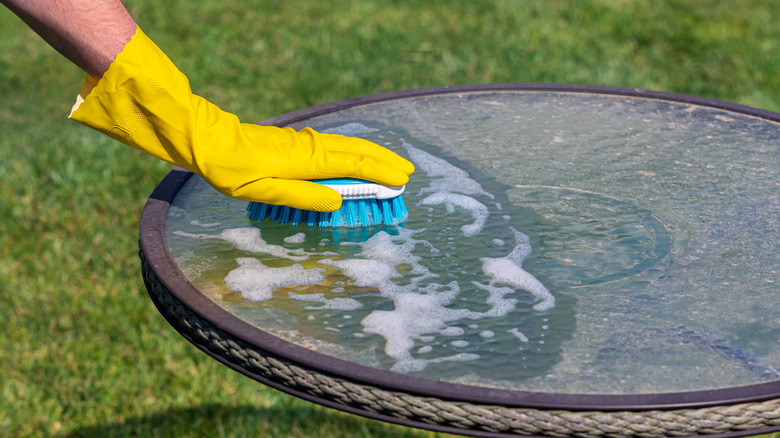The Common Cleaning Agent You Should Never Use On Outdoor Furniture
We may receive a commission on purchases made from links.
When the weather is nice, it's an ideal time to give your outdoor furniture a good, thorough clean to remove any stains and get ready to entertain friends. While your furniture is durable and able to withstand the tough conditions outside, it's not suitable for every cleaning product. One common cleaning agent you should never use on outdoor furniture is acetone or any acetone-based product. Acetone is an effective solvent for breaking down grease, paint, or nail polish. For this reason, it can easily damage or discolor outdoor furniture. Whether made of plastic, vinyl, wood, or metal, using acetone is one of the outdoor furniture cleaning mistakes to avoid at all costs. In your quest to remove stains, you may leave your chair or loveseat looking worse than when you started.
Patio furniture often sits out in the elements year-round, collecting stubborn stains from dirt, grime, and even mold. The best approach to cleaning outdoor furniture is with gentle options such as soap and water or products recommended in your owner's manual. Even baking soda is an all-natural cleaning hack that can make your outdoor furniture sparkle. Many manufacturers may also list recommended cleaners, such as CLR Brands Outdoor Furniture Cleaner. Whatever cleaner option you use, ensure it's not abrasive and always test in an inconspicuous spot. Avoid machine-washing anything unless the manufacturer states it's machine-washable. Now that you know that acetone shouldn't be used to clean your outdoor furniture and what to use instead, here's why.
Reasons not to use acetone for cleaning your outdoor furniture
Acetone is commonly used as a dissolver of various substances, and as such, it's too harsh for most outdoor furniture, regardless of construction. Using acetone and acetone-based products may cause bleaching or discoloration, especially in fabrics. Consider the fact that the same product can take off your unwanted nail polish in a few seconds, and you can imagine what it would do to your outdoor chaise. Many pieces of outdoor furniture can feature UV-resistant or sun-resistant fabrics, which are especially treated against fading and degrading by the sun's UV rays. These materials often use synthetic fibers and protective coatings. Not only will acetone potentially leave white spots in the fabric, but it could also reduce its effectiveness against the sun.
If working with furniture made of any plastic elements, it's even more important to avoid using acetone when you clean it. The chemical may soften the plastic, weakening it and making it easier to crack, pit, or warp over time. Using weakened or brittle furniture could be dangerous, potentially causing injury if the plastic breaks from too much pressure. Wicker and rattan furniture is also susceptible to damage from acetone, as it can weaken the fibers, compromising the structural integrity. Wood furniture isn't immune either, especially if painted or coated, as acetone may quickly remove the finish. In addition to acetone's effects on furniture construction materials and fabrics, it's also a strong chemical solvent that's highly flammable, potentially becoming explosive when the vapor mixes with hot air. For all of these reasons, it's best left alone.

